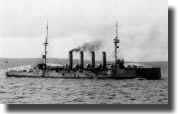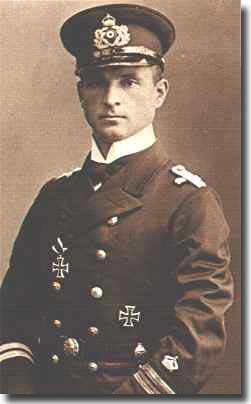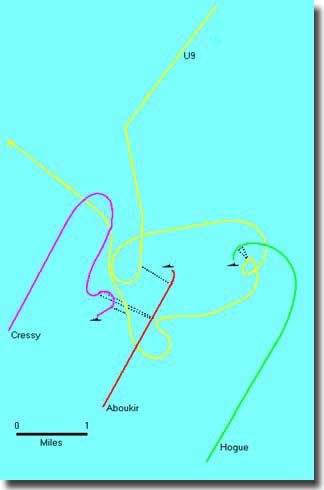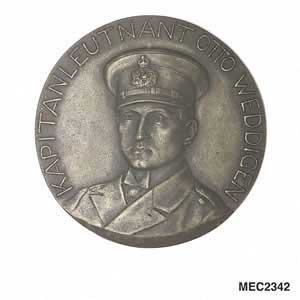Introduction.
In the early days of WW1, Cruiser Force C, made up of old Cressy class armoured cruisers patrolled part of the North Sea close to the Hook of Holland. Senior Naval Officers were opposed to this patrol on the grounds that these ships were very vulnerable to any attack from Germany's more modern surface ships, and advised the Admiralty accordingly. This patrol was nicknamed: "The live bait patrol."
Nonetheless, my Lords of the Admiralty ignored this advice, and persisted with this operation, insisting that Destroyers could not be involved because of the frequent bad weather that prevailed in the area, and also, because modern light cruisers were just unavailable.
 |
 |
| HMS Cressy,the first armoured cruiser in the Royal Navy. Sunk by the German U9, alongside her sister ships, Aboukir and Hogue on the 22nd. of September 1914. |
German submarine U9 |
The patrol set up on the 20th. of September 1914.
Early into the 20th. of September 1914, HM cruisers, Euryalis, Aboukir, Hogue and Cressy were about to leave on patrol with Rear Admiral Christian in his flagship Euryalis in charge. It was normal for Rear Admiral Campbell in Bacchantes to command these operations, but he was absent, so it was left to Christian to take over on this occasion.
It was too rough for the destroyers to be involved, and the cruisers sailed without any such escort, very soon after departure, Euryalis was forced to drop out from lack of coal, and damage to her wireless equipment. ( It does seem to be poor planning and staff work, to include Euryalis, and allow her to sail, when she carried insufficient coal. )
The weather was too rough to even allow Rear Admiral Campbell to stay in command by transferring his flag to another cruiser, he had to delegate command to Captain Drummond in Aboukir, but did not clearly state that Drummond could order the destroyers to sea in the event that the weather moderated, which in fact it did towards the end of the 21st.
Thus, the elderly British cruisers were bereft of any destroyer support, and in the event of hostile submarines operating in the area, this lack of clear orders could prove to be fatal.
September the 22nd. 1914.
The three cruisers were steaming blissfully North North East at a leisurely 10 knots, and were not zigzagging to deter any hostile submarine in the vicinity. Otto Weddingen, commanding the German submarine U9, would not believe his luck when in his periscope appeared not one, not two, but three British light cruisers.

CO of U9, Kptlt. Otto Weddingen ( 1880- 1915 )
At 0625 ( 6.25 AM ) a single torpedo was fired at Aboukir, shortly after hitting her on the port side, she quickly flooded, and lost engine power, soon to be abandoned by Captain Drummond and his crew. At first, he thought his ship had struck a mine, and he ordered his two other cruisers to close and assist.
Too late he realised his awful mistake, his ship had been torpedoed, and he was merely setting them up for U9 to sink. Aboukir sank within 30 minutes, U9 fired two torpedoes at Hogue hitting her amidships, she flooded quickly in her engine room.
U9 lost trim from firing these last two torpedoes, and briefly broke surface, to be fired upon by Hogue, but to no effect, and in another 10 minutes Hogue had sunk.
Now, U9 went after the last cruiser still afloat, Cressy had stopped, lowering boats to pick up survivors, a big mistake, on sighting a periscope she quickly got under way again, but she too was doomed. At 7.20 ( 7.20AM ) of two torpedoes fired at her, one missed, but the
second struck her starboard side but did not prove fatal.
Now U9 turned to loose off her last remaining torpedo, her Captain making sure he did not miss, it ran both straight and true, struck home to sink Cressy within 15 minutes.

U9 has an absolute picnic, sinking all three British cruisers
U9's First Watch Officer watches in horror through the periscope.
Oberleutnant z. S. Johannes Spiesz, the U-Boats First Watch Officer made this revealing comment: "In the periscope, a horrifying scene unfolded. We present in the conning tower, tried to supress the terrible impression of drowning men, fighting for their lives in the wreckage, clinging to capsized life boats."
Some are rescued.
The Dutch Merchant ships Flora and Titan, plus British Trawlers JGC, and Corainder combed the devastated area looking for survivors to pick up, Flora arrived in Holland with 286 rescued British sailors, who were returned to England. Strictly speaking, Holland being neutral should have interned them for the duration of the war, but the Dutch authorities saw fit to flout that convention.
In all, only 837 were hauled from the carnage, but 1,459 Officers and men died from the three British cruisers.
U9 survived the war.
U9 saw out WW1, to surrender on the 26th. of November 1918, and was broken up at Morecombre in 1919.
Conclusion.
This patrol by armoured cruisers was later abandoned. A Court of Inquiry sought someone to blame, and most of the Senior Officers involved were castigated, Captain Campbell for not zig zagging, and for not ordering out the Destroyers after the weather had moderated. Rear Admiral Christian for not issuing clear orders to Captain Drummond, Rear Admiral Campbell for not being available and missing the action in his ship, and for his poor showing at the Inquiry, he had come up with the lame excuse: "He did not know what the purpose of his command was." How pathetic, and from a Rear Admiral in the Royal Navy, he was obviously quite unfit, in my view, to be in command.
Most of the blame fell upon the Lords of the Admiralty ( quite properly I believe ) for persisting in ordering this patrol, that was dangerous with the old cruisers sent out, was of limited value anyway, and against all the advice of the sea going Senior Officers.

Crew of U9, decorated with the Iron Cross for their successful
attack in sinking three British Cruisers. September 1914.
A sad affair resulting in such a high loss of life, many of them Cadets and Reservists.
It is so easy for those who are in charge in time of war, but who are safe at home, to make fatal decisions that wind up, sending service personnel to their death. But then, has anything really changed so many years and so many warlike operations later?
Medal struck in Germany.
To mark this victory, a Medal was struck in Germany, it was a bust of Captain Lieutenant Otto Weddingen, in uniform.

Medal struck in Germany to commemorate the victory by Captain Lieutenant Otto Weddingen
in sinking the three British light cruisers, Aboukir, Hogue and Cressy. September 1914
Post Script.
Otto Weddingen sank the British Cruiser HMS Hawker in October 1914, he changed command to U29, and in February of 1915 sank four Merchant ships. He had published his book: "The First Submarine Blow," and had been awarded the prestigious decoration Pour le Merite ( The Blue Max ) but did not live to enjoy his success. He died on the 18th. of March 1915, when U29 was rammed by the British HMS Dreadnought, and sliced in half.

The Pour le Merite ( Blue Max ) instituted in 1740, was last awarded in 1918.
It was awarded to Otto Weddigen for his sinking of three British Cruisers, Aboukir, Hogue, and Cressy







